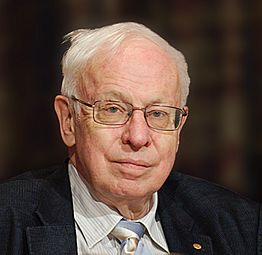Tomas Lindahl facts for kids
Quick facts for kids
Tomas Lindahl
FRS FMedSci
|
|
|---|---|

Lindahl in 2015
|
|
| Born |
Tomas Robert Lindahl
28 January 1938 Stockholm, Sweden
|
| Nationality | Swedish, naturalised British (dual nationality) |
| Alma mater |
|
| Known for | Clarification of cellular resistance to carcinogens |
| Awards |
|
| Scientific career | |
| Fields |
|
| Institutions |
|
| Thesis | On the structure and stability of nucleic acids in solution (1967) |
Tomas Robert Lindahl (born 28 January 1938) is a Swedish-British scientist. He is famous for his work in cancer research and understanding how our bodies fix damaged DNA. In 2015, he won the Nobel Prize in Chemistry along with Paul L. Modrich and Aziz Sancar. They received the award for their important discoveries about how DNA repair works.
Early Life and Education
Tomas Lindahl was born in Stockholm, Sweden. He grew up there and later studied at the Karolinska Institutet. In 1967, he earned his PhD degree. This degree is a high academic qualification for researchers. He also completed an MD degree qualification in 1970.
Career and Research Discoveries
After finishing his studies, Lindahl traveled to the United States. He did more research at Princeton University and Rockefeller University. These are well-known universities where scientists do advanced studies.
From 1978 to 1982, he was a professor at the University of Gothenburg in Sweden. In 1981, he moved to the United Kingdom. There, he joined the Imperial Cancer Research Fund, which is now called Cancer Research UK. This organization focuses on finding cures for cancer.
From 1986 to 2005, Lindahl was the first Director of the Clare Hall Laboratories. These labs are part of the Francis Crick Institute today. He continued his research there until 2009.
Lindahl's most important work is about DNA repair. DNA is like a blueprint for our bodies. It can get damaged by things like sunlight or chemicals. Lindahl discovered how cells fix these damages. His research helped us understand how our bodies protect themselves from cancer. He also studied the genetics of cancer.
Awards and Recognitions
Tomas Lindahl has received many important awards for his scientific work.
- In 1974, he became an EMBO Member. EMBO is an organization for leading life scientists.
- In 1988, he was elected a Fellow of the Royal Society (FRS). This is a very high honor for scientists in the UK.
- In 1998, he became a founding Fellow of the Academy of Medical Sciences (FMedSci).
- In 2007, he received the Royal Medal from the Royal Society. This award recognized his major contributions to understanding DNA repair.
- In 2010, he was awarded the Copley Medal. This is the Royal Society's oldest and most prestigious award.
- In 2018, he was elected a foreign associate of the National Academy of Sciences in the USA.
His biggest award came in 2015 when he shared the Nobel Prize in Chemistry. The Nobel Prize committee recognized him, Paul Modrich, and Aziz Sancar. They were honored for their detailed studies on how DNA repair mechanisms work. Their discoveries have greatly improved our understanding of how living things survive and how diseases like cancer develop.
See also
 In Spanish: Tomas Lindahl para niños
In Spanish: Tomas Lindahl para niños

